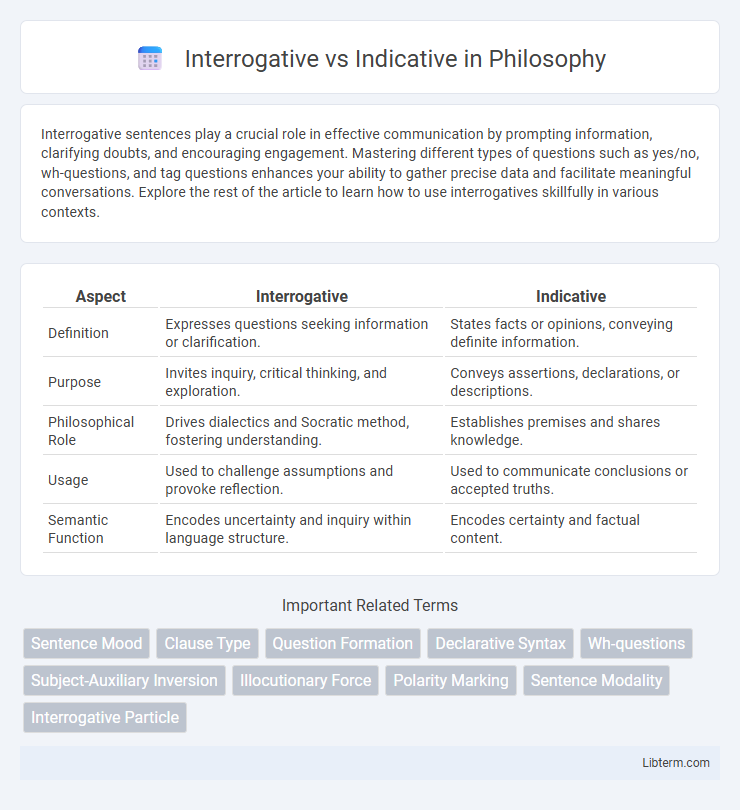Interrogative sentences play a crucial role in effective communication by prompting information, clarifying doubts, and encouraging engagement. Mastering different types of questions such as yes/no, wh-questions, and tag questions enhances your ability to gather precise data and facilitate meaningful conversations. Explore the rest of the article to learn how to use interrogatives skillfully in various contexts.
Table of Comparison
| Aspect | Interrogative | Indicative |
|---|---|---|
| Definition | Expresses questions seeking information or clarification. | States facts or opinions, conveying definite information. |
| Purpose | Invites inquiry, critical thinking, and exploration. | Conveys assertions, declarations, or descriptions. |
| Philosophical Role | Drives dialectics and Socratic method, fostering understanding. | Establishes premises and shares knowledge. |
| Usage | Used to challenge assumptions and provoke reflection. | Used to communicate conclusions or accepted truths. |
| Semantic Function | Encodes uncertainty and inquiry within language structure. | Encodes certainty and factual content. |
Understanding Interrogative and Indicative Sentences
Interrogative sentences are structured to ask questions, often beginning with question words like who, what, where, when, why, or how, and they typically end with a question mark to indicate inquiry. Indicative sentences, on the other hand, state facts or opinions and use a straightforward subject-verb-object order, ending with a period. Understanding the distinction between interrogative and indicative sentences is essential for effective communication, as it aids in recognizing when information is being requested versus when information is being provided.
Key Differences Between Interrogative and Indicative Forms
Interrogative forms are used to ask questions, typically marked by a subject-auxiliary inversion and often ending with a question mark, whereas indicative forms state facts or opinions without inversion. The key difference lies in their function: interrogatives seek information, while indicatives provide information. Interrogative sentences often begin with question words like "who," "what," or "where," whereas indicative sentences follow a standard subject-verb-object order.
Structure of Interrogative Sentences
Interrogative sentences are structured to elicit information and typically begin with a question word such as "who," "what," "where," "when," "why," or "how," followed by subject-verb inversion, as in "Where are you going?" In contrast, indicative sentences state facts or opinions, following a standard subject-verb-object order, for example, "She is going to the store." The structure of interrogative sentences often involves auxiliary verbs ("do," "does," "is," "are") preceding the subject to form yes/no questions, highlighting their distinctive syntax compared to indicative sentences.
Structure of Indicative Sentences
Indicative sentences typically follow a subject-verb-object structure, expressing factual information or statements. The verb in indicative mood aligns with the subject in number and tense, providing clarity and precision. This straightforward syntactic arrangement distinguishes indicative sentences from interrogative forms, which often involve inversion or auxiliary verbs.
Common Uses of Interrogative Sentences
Interrogative sentences are primarily used to ask questions, seeking information, clarification, or confirmation from the listener or reader. They commonly start with question words like who, what, where, when, why, and how, or use auxiliary verbs such as do, does, is, and are. Indicative sentences, by contrast, state facts, opinions, or describe events without requesting information.
Common Uses of Indicative Sentences
Indicative sentences primarily convey factual information, statements, or descriptions, making them essential for clear communication in both written and spoken English. They are commonly used to express facts, opinions, or beliefs, such as in declarative statements like "The sky is blue" or "She enjoys reading." Unlike interrogative sentences, indicative sentences do not seek answers but rather provide information.
Interrogative vs Indicative: Examples in Context
Interrogative sentences ask questions and typically begin with words like who, what, where, when, why, or how, for example, "Where is the meeting tomorrow?" Indicative sentences make statements or express facts, such as "The meeting is scheduled for 10 AM." In context, the difference is clear: interrogative sentences seek information, while indicative sentences provide information.
Importance in Effective Communication
Understanding the difference between interrogative and indicative sentences is crucial in effective communication because interrogative sentences elicit information, promote clarity, and encourage engagement through questions. Indicative sentences convey statements, facts, or opinions, providing clear and direct information essential for comprehension. Mastering the use of both sentence types enhances conversational flow, ensuring messages are both understood and interactive.
Mistakes to Avoid with Interrogative and Indicative Sentences
Mistakes to avoid with interrogative sentences include using improper question word order and failing to add a question mark, which can confuse meaning and reduce clarity. Indicative sentences often suffer from errors such as incorrect subject-verb agreement and missing punctuation, disrupting the delivery of factual information. Ensuring correct syntax and punctuation in both sentence types is essential for effective communication and minimizing misunderstandings.
Tips for Mastering Sentence Types in Writing
Interrogative sentences ask questions and often start with words like who, what, where, when, why, or how, making them essential for gathering information or engaging readers. Indicative sentences state facts or opinions, providing clarity and coherence in writing by delivering straightforward information. To master these sentence types, practice integrating precise question forms to stimulate curiosity while balancing them with clear, assertive statements that maintain the flow and purpose of your narrative.
Interrogative Infographic

 libterm.com
libterm.com